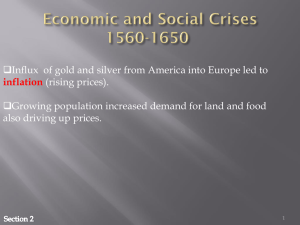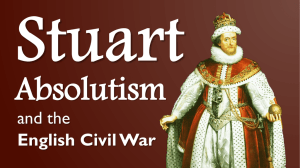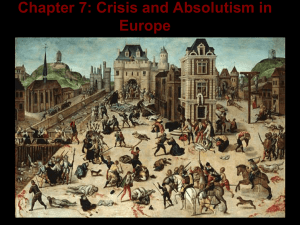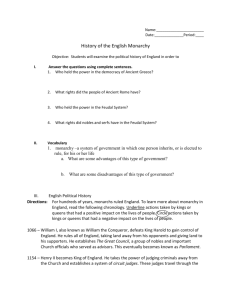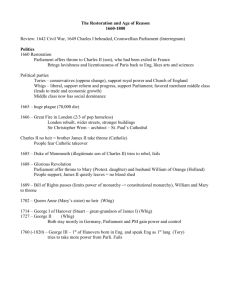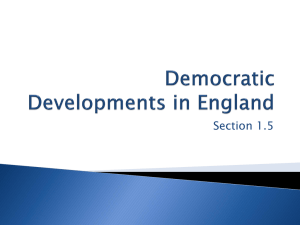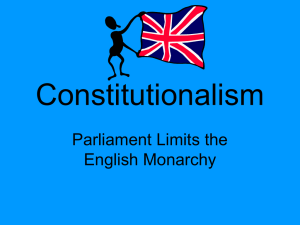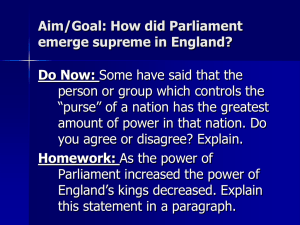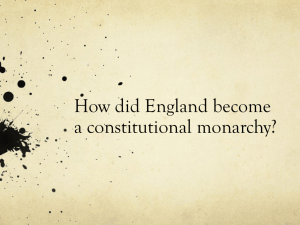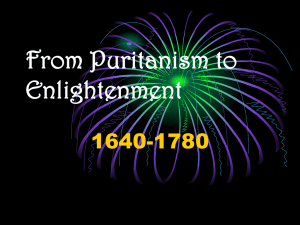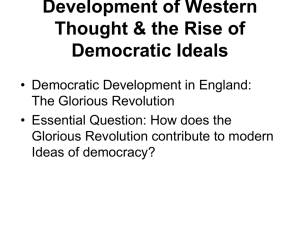Chapter 14-2
advertisement
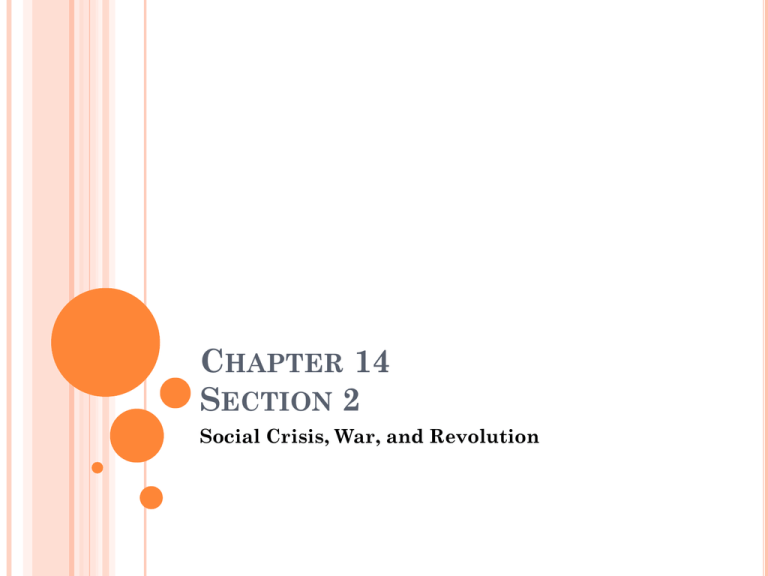
CHAPTER 14 SECTION 2 Social Crisis, War, and Revolution OBJECTIVES: Describe the results of the Thirty Years’ War Explain the Witchcraft Trials Analyze the revolutions in England ECONOMIC AND SOCIAL CRISIS Economic problem- Inflation: rising prices From 1560-1650 Europe experienced economic and social problems. Gold from Americas, Increased Population 1600- Economic slowdown, Spain’s economy fell by 1640 due to less American silver, pirates, and decrease in artisans. 1620- Population declined THE WITCHCRAFT TRIALS Belief in witchcraft, or magic, had been culturally significant for centuries. The Inquisition soon focused on witchcraft, and Europe was seized with hysteria. More than 1,000 people were accused, and 75% were women. Accused witches were tortured and usually confessed to various things. By 1650 the witchcraft hysteria had lessened, and as government strengthened they were not tolerant to disruptions. THE THIRTY YEARS’ WAR Religious disputes continued in Germany after the Peace of Augsburg in 1555 Reason: It didn’t recognize Calvinism. Religion, politics, and territory all played a role in the Thirty Years’ War, called the “last of the religious wars.” The war began in the Holy Roman Empire in 1618 as a fight between the Hapsburg HRE and the Protestant nobles in Bohemia. The nobles rebelled against the Hapsburgs, and all major European countries but England became involved. Struggle between France and Spain with the HRE for European Leadership. Battle took place on German soil. Ended by The Peace of Westphalia in 1648, with France as the victor. The Peace of Westphalia said that all German states could decide their own religion and ended the Holy Roman Empire. Germany would be divided for nearly 200 years. HIGHLIGHTS OF THE THIRTY YEARS WAR Most destructive war of Europe to date. Flintlock musket with bayonet Increased use of firearms, more movable armies, and government supported military. By 1700, France had a standing army of 400,000. REVOLUTIONS IN ENGLAND Where in the world is there still conflict between Catholics and Protestants? 17th century saw England’s civil war, known as the English Revolution. It was a struggle between Parliament and the king to determine the power of each in governing England. THE STUARTS AND DIVINE RIGHTS The Tudor dynasty ended with Elizabeth’s death in 1608. The Stuart king of Scotland, James I, ascended the throne. He believed in the divine right of kings, but Parliament wanted an equal role in governing England. Puritans (one group of English Calvinists) disagreed with the kings defense of the Church of England, wanting it to be more Protestant. Religion was an issue as well. Many Puritans served in the House of Commons, giving them power. Conflict erupted under Charles I, who believed in the divine right of kings, like his father. 1628: Parliament passed a petition prohibiting passing taxes without their consent. At first Charles agreed, but later changed his mind. Charles also tried to add rituals to the Protestant service, which Pilgrims believed was like Catholicism. Thousands of pilgrims went to the America’s rather than follow Charles’s religious policies. CIVIL WAR AND THE COMMONWEALTH Civil War broke out in 1642 between supporters of the kings (Cavaliers, or Royalists) and those of Parliament (Roundheads) Roundheads won largely because of the New Model Army and it’s leader, Oliver Cromwell. Cromwell’s army was made up of extreme Puritans, known as Independents, who believed they were doing battle for God. Cromwell purged Parliament of those who did not support him. Had Parliament execute Charles I in 1649, which horrified Europe. Parliament abolished the monarchy and the House of Lords, and declared a republic, or commonwealth. Cromwell soon dismissed Parliament and set up a military dictatorship, and ruled until his death in 1658. THE RESTORATION Parliament restored the monarchy. Parliament regained new control and restored the Church of England. Charles II took the throne and under the restored Stuart monarchy. This restricted the rights of Catholics and Puritans. In 1685, James II became king. He was a devote Catholic. THE GLORIOUS REVOLUTION Parliament did not want James II’s Catholic son to assume the throne. English noblemen invited the Dutch leader, William of Orange, husband of James’s daughter Mary, to invade England. William and Mary raised an army and marched to England. James and his family fled with almost no violence, and England underwent its “Glorious Revolution”- but who would be monarch? William and Mary accepted the throne in 1689, along with the Bill of Rights The Bill of Rights: allowed Parliament to make laws and raise taxes Citizens allowed to bear arms Trial by jury Created a government based on the rule of the law and a freely elected Parliament. Laid the grounds for a limited, or constitutional, monarchy The Toleration Act of 1689 gave Puritans, not Catholics, the right of free public worship. Few English citizens were persecuted for religion ever again. By deposing one king and establishing another, Parliament had destroyed the divine right theory of kingship. CLOSURE: Top 5 on Section 2 HOMEWORK/CLASSWORK Page 439 1,2,4-6
